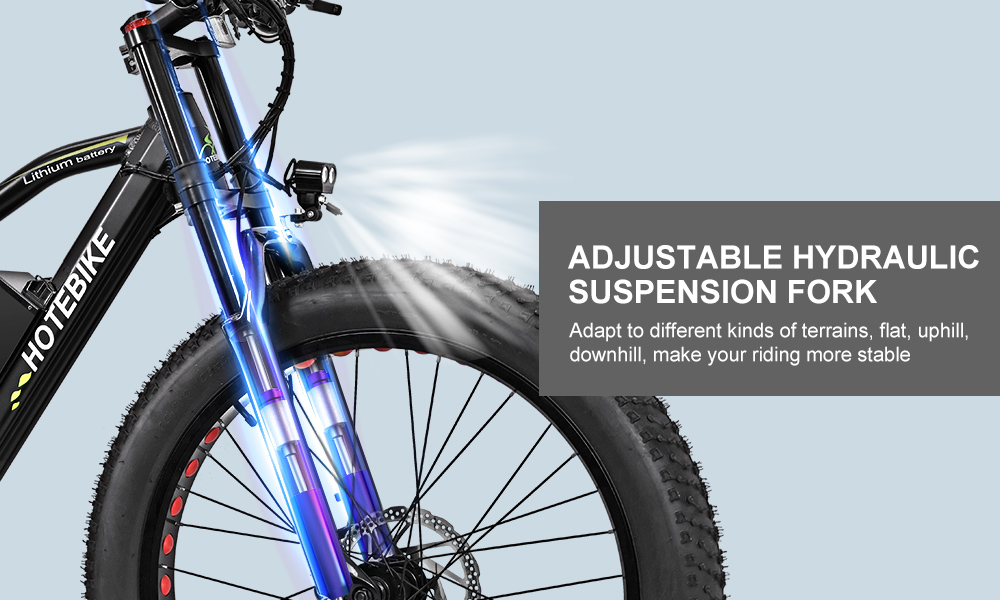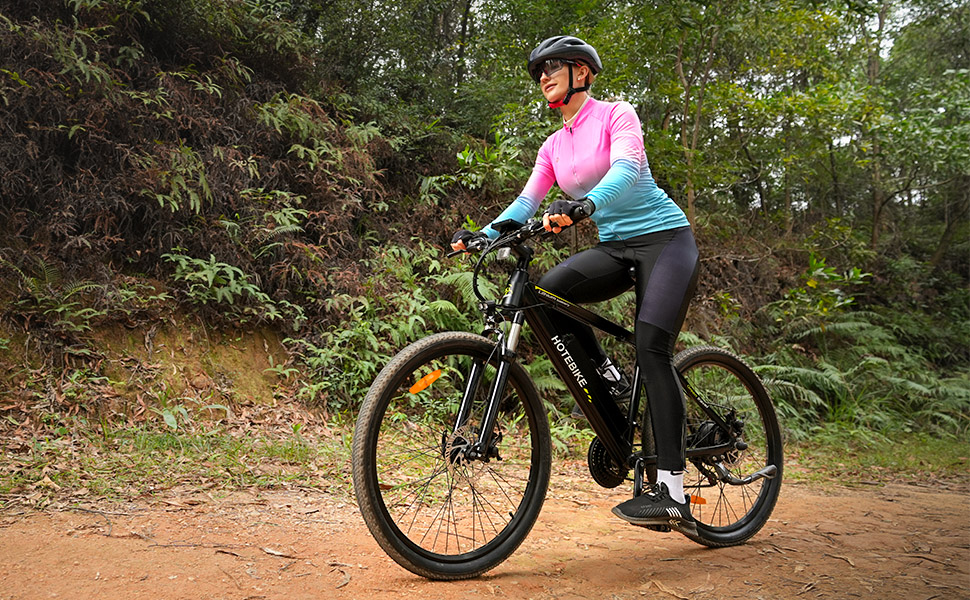Are you still looking for a more comfortable, smoother electric bike? Or are you looking for an electric bike that can handle tough terrain and maintain high speeds on off-road adventures?If you’re having these troubles, check out this article with some tips on electric bike suspension.
Here’s more information about e-bike suspension, what it is, its importance, types and what you should consider when buying an e-bike, and more.
What is E-Bike Suspension?
An electric bike suspension is a system that allows the bike to absorb bumps and vibrations, making it more comfortable and stable to ride. It consists of a set of springs and shock absorbers that absorb bumps, potholes and other road imperfections, reducing shocks and vibrations. The suspension also reduces the amount of energy lost to the road, allowing the rider to pedal more efficiently and thus go farther on each charge. With good suspension, e-bikes can be ridden easily and comfortably over rough terrain.
E-bike suspension is now a common protective component on most e-bikes. It consists of a set of springs and shock absorbers that absorb the effects of bumps, potholes and other road imperfections, reducing shock and vibration.
It acts as a cushion between you and your e-bike when you ride on rough roads, reducing the impact of the road and allowing the bike to absorb bumps and vibrations, making it a more comfortable and stable ride. The suspension also allows you to expend less effort, enabling you to pedal more efficiently so you can go further without getting tired every time.

Therefore, an electric bike with suspension is essential if you want to ride more easily over rough terrain.
However, there are different types of suspension, which can affect the performance of an e-bike. The suspension of an electric bike can extend the life of the frame. Riding an e-bike on a surface like a mountain, a bike without suspension wears out and breaks down quickly.
E-bike suspension also has disadvantages, most notably price. E-bikes with suspension are much more expensive than those without. Some cyclists buy conventional bikes and install suspension systems, but they too are expensive. In addition, the suspension system acts like an extra device on the e-bike, adding weight. To improve shock absorption, the frame of a suspension e-bike is heavier. In addition, e-bike suspension requires more maintenance; otherwise, it won’t work properly.
The Importance of Suspension
First, the suspension absorbs the effects of rough and uneven terrain, making your ride smoother, more comfortable and safer.
Second, suspension helps reduce fatigue when riding, because it allows you to spend less effort to go farther. This helps to reduce the risk of injury and makes it possible to ride longer distances.
Third, the suspension gives you better control of the bike, making it easier to navigate terrain and corners.
Fourth, it can help maximize overall speed by providing better control and traction when cornering.
Finally, the suspension improves the stability of the bike and reduces the risk of losing control and crashing.
Types of Suspensions for Electric Bicycles
When you need to buy an electric mountain bike, you will come across those with front suspension, rear suspension, full suspension and much more. Understanding the differences between these types of e-bikes and the difference they will make to your riding experience is important to ensure you get the best e-bike for your needs.
Front Suspension
The front suspension is the most basic type and is usually found on entry-level e-bikes.
It consists of two struts that connect the front wheel of the e-bike to the head tube of the bike frame (the almost vertical part of the bike frame that runs from under the handlebars to the front wheel) and helps absorb bumps and shocks from the road.
The front suspension is usually adequate for everyday riding – for example, if you commute to work or ride for exercise.

Rear Suspension
The rear suspension is a more advanced type of suspension that helps improve the comfort and stability of your e-bike. It consists of a coil spring (not an air spring).
The additional shock absorber at the rear helps absorb shocks and improves tire-ground contact, which improves control and reduces fatigue.
Full Suspension
The full suspension is the most advanced type, providing the best ride quality. It consists of a front fork and a rear shock absorber.
For example, mountain e-bike riders can benefit from a full suspension system because trail bikes often involve bumpy, unpaved terrain.
Full-suspension bikes typically offer a more comfortable ride than hardtail bikes (the term for bikes with only one suspension). That said, full suspension bikes are typically more expensive to purchase and maintain. They are also heavier.
While it may seem like the more suspension the better, this is not always the case. Which one is best for you depends on who you are, and how and where you want to ride.
If you plan to ride over dangerous trails in extremely extreme mountains and plan to do a lot of downhill racing, then you may want to consider a full suspension bike. They usually offer maximum absorption and can improve handling in those situations.
Most people don’t need (and probably don’t want) a full suspension bike for all but the most extreme trails.
Factors to Consider when Buying
When buying an e-bike, it is also important to consider the type of type of suspension.
What type of suspension do I really need? The answer is also very simple.
When considering what type of e-bike suspension you need, the type of riding you plan to do, the terrain you will be riding on, and your personal preferences. For example, a simple front suspension system may be adequate if you rely primarily on smooth roads or bike paths. However, if you plan to ride off-road or on rough terrain, a full suspension system may be more appropriate.
Keep in mind that more suspension doesn’t always make for a better ride. It’s the overall bike and its features as a whole that you must evaluate to get the best ride for your needs.
Summary
The e-bike suspension increases control and comfort when riding on uneven terrain, providing a smoother, more comfortable ride and improved handling. It contributes to the happiness of your ride.
Of course, there are disadvantages to each type. It is up to you to make your choice based on the actual situation.
Front forks are the most common type of suspension on e-bikes. They provide a good break and are relatively easy to install. Rear shocks offer a smoother ride, but can be more difficult to install. Full suspension e-bikes offer the best of both worlds, but can be more expensive.
When choosing an e-bike suspension, it is important to consider your budget, riding style, and what type of terrain you will be riding on.
Thank you for reading and we hope this article was helpful to you!
 hotebike
hotebike
